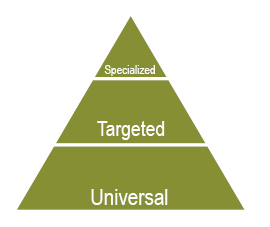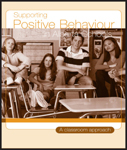
|
Universal Supports benefit all students
- Help students develop an understanding of the importance of good grooming through class discussion, brainstorming of benefits and describing or illustrating examples and nonexamples of good grooming habits. When providing examples, consider what students at this age level have control over (e.g., they may be able to choose to wash their hands during the school day but they may not have always have access to clean clothes at home).
- Develop classroom routines that promote and facilitate good grooming habits, such as providing time for hand washing throughout the school day.
- Help students develop an understanding of the importance of personal hygiene through class discussion, brainstorming of benefits and describing or illustrating examples and nonexamples of personal hygiene habits, such as frequent hand washing, covering mouth when sneezing or coughing, using tissue to blow nose, refraining from touching nose and mouth, keeping objects out of mouth, covering cuts and sores, and not sharing personal items (e.g., water bottles).
- Look for natural opportunities throughout the school year (e.g., at the beginning of cold and flu season) to reinforce good habits related to personal hygiene and discuss the importance of frequent hand washing and covering mouth when coughing or sneezing.
- Develop classroom routines that promote and facilitate good hygiene, such as having tissues accessible at all times, allowing students to leave the room to wash hands, or building in time to wash down desks or clean water bottles.
- Post visual reminders with
tips for staying healthy through personal hygiene habits, such
as hand washing or covering mouth when coughing or sneezing.
When appropriate, collaborate with students to develop these
visual reminders.
|
|

|
Targeted Supports benefit students with more specific needs
- Provide a supply of combs, toothbrushes or other grooming and/or personal hygiene items that, if needed, individual students can access and keep at school for their own personal use.
- If individual students' grooming or personal hygiene is interfering in their relationships with others or posing a health risk, collaborate with parents to develop strategies for developing improved skills related to grooming and/or personal hygiene.
- If necessary, work with individual or small groups of students to teach, practise and review specific and targeted skills related to grooming and/or personal hygiene.
- Work with individual students to develop low-key cues and prompts to provide on-the-spot reminders for targeted hygiene-related behaviours, such as using a tissue or keeping objects away from the mouth.
- Develop personalized checklists to reinforce these skills and habits and place them on the student's desk (or other discrete place) where he or she can see and use them independently. Some students may wish to carry the checklists with them. When possible, include graphics or actual photos of students.
|
Parents know their children well and can offer insights on how to support
their social and emotional well-being. There is strength in collaborating
on strategies that could be used at home, at school and in the community.
|

|
Specialized Supports benefit the small number of students with sensory, physical, cognitive or behavioural needs that require intensive, individualized interventions
- In exceptional cases, an individual student may need 1:1 adult support for toileting and/or other aspects of personal care. This support should be provided as unobtrusively and naturally as possible, with minimal interference to learning and social opportunities. In addition, the adult providing this 1:1 support should collaborate with the student's learning team to identify and facilitate as many ways as possible to create opportunities, provide strategies, modify activities and adjust and/or fade support so the student can experience some degree of independence throughout the school day.
- In exceptional cases, building modifications may need to be considered to provide privacy to students with medical and/or physical personal care needs.
|
|








